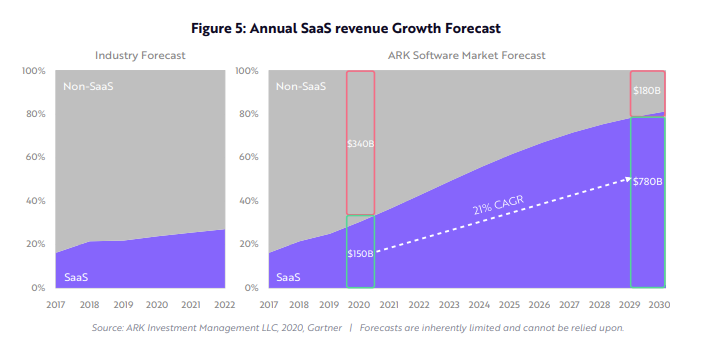SaaS is a cloud-based, subscription-based software distribution model. It offers advantages such as the elimination of hardware management, easy access via the Internet, low initial costs and reduced maintenance. For publishers, it generates recurring revenues and simplifies software upgrades.
Famous companies include Microsoft, Atlassian, Adobe, Zoom, Asana, MongoDB, Veeva Systems, Wix, Shopify, Bigcommerce, Automatic Data Processing, Monday.com, Paycom Software, Workday, Datadog, Snowflake, Intuit, Twilio, Crowdstrike, Elastic, Okta, Rapid7 , Splunk.
The rise of SaaS companies is due to a combination of abundant private equity, the availability of cloud computing and the growing demand for specialized software (vertical market). Digital transformation in all sectors has also stimulated demand for such solutions.
These businesses have demonstrated impressive growth and superior returns compared to other consumer technology companies. SaaS business models, focused on viral and self-service customer acquisition strategies, have enabled increased efficiency.
SaaS is advantageous for developers, customers and investors, encouraging widespread adoption. Traditional companies are migrating to SaaS, while the majority of new software IPOs are adopting this model. It therefore appeals to companies and investors alike.
Expectations for the SaaS market are high, with estimated annualized growth of 21% over the next decade. It should reach $780 billion by 2030, according to Ark Invest (see chart below). It represents a key driver of global productivity and offers promising investment opportunities.

Source: Ark Invest
Digital transformation has driven companies to adopt software to improve efficiency in a variety of areas. The SaaS model plays a key role in this transformation, providing agile and scalable tools for businesses. It benefits from the decentralization of IT purchasing, enabling individual departments to adopt new software rapidly. What's more, it now addresses every worker, considerably expanding its total addressable market (TAM).
Today's multi-billion-dollar IT industry has grown thanks to continuous improvements in cost and ease of use. The simpler it is to acquire, deploy, maintain and use IT systems, the larger the potential market. If past innovations, such as graphical user interfaces, have simplified the use of computers, cloud computing has revolutionized the lifecycle of enterprise IT systems, from purchase to maintenance.
IT systems, whether infrastructure or software, have become on-demand services (SaaS, IaaS, etc). With a penetration rate of just 25%, the SaaS segment offers significant growth potential over the coming years. Thanks to a unique combination of ease of integration and recurring revenues, SaaS companies could be particularly well positioned to capture a significant share of future technology revenues.
Major investment themes take years, even decades, to evolve from ideas into enduring, secular industries. Initiated over a decade ago, SaaS has attracted mass demand in just a few years. With companies of all sizes adopting new digital workflows, the next decade could prove to be the golden age of SaaS.

 By
By 












